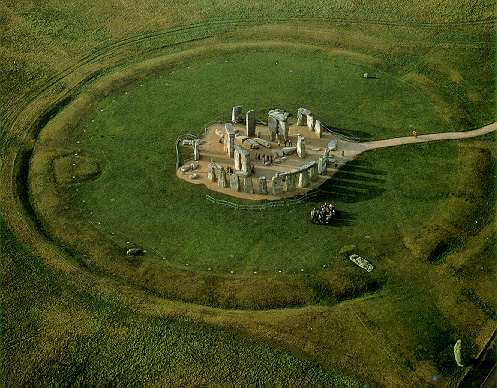
The megalithic ruin known as Stonehenge stands on the open downland of Salisbury Plain two miles (three kilometres) west of the town of Amesbury, Wiltshire, in southern England.
It consists of a series of earth, timber, and stone structures that were built, revised and re-modelled over a period of more than 1400 years.
In the 1940s and 1950s, Richard Atkinson, Stonehenge (London: H. Hamilton, 1956), proposed that construction occurred in three phases, which he labelled Stonehenge I, II, IIIa, IIIb, and IIIc.
This sequence has recently been revised (see Stonehenge in Its Landscape: Twentieth-Century Excavations, Archaeological Report 10, published in London in 1995 by English Heritage) and is outlined below.
Phase I (2950-2900 BCE)

Stonehenge Phase I (2950-2900 BCE) The earliest portion of the complex dates to approximately 2950-2900 BCE (Middle Neolithic). It is comprised a circular bank, ditch, and counterscarp bank of about 330 feet (100 metres) in diameter. Just inside the earth bank is a circle of the 56 Aubrey holes that held wooden posts.
Phase II (c. 2900-2400 BCE)
The Aubrey Holes no longer held posts but were partially filled, some with cremation deposits added to the fill.
The numerous post holes indicate timber structures but no clear patterns or configurations are discernible that would suggest their shape, form, or function.
Phase III (c. 2550-1600 BCE)

Stonehenge Phase III, sub-phase 3ii (c. 2550-1600 BCE) The Sarsen Circle and the Trilithon Horseshoe
During Phase III the monument underwent a complicated sequence of settings of large stones.
The first stone setting comprised a series of Bluestones placed in what are known as the Q and R Holes (sub-phase 3i).
These were subsequently dismantled and a circle of Sarsens and a horseshoe-shaped arrangement of Trilithons erected (sub-phase 3ii).
The Sarsen Circle, about 108 feet (33 metres) in diameter, was originally comprised of 30 neatly trimmed upright sandstone blocks of which only 17 are now standing.
The stones are evenly spaced approximately 1.0 to 1.4 metres apart, and stand on average 13 feet (4 metres) above the ground. They are about 6.5 feet (2 metres) wide and 3 feet (1 metre) thick and taper towards the top.
They originally supported sarsen lintels forming a continuous circle around the top. Each lintel block has been shaped to the curve of the circle.
The average length of the rectangular lintels is 10 feet 6 inches (3.2 metres).
The lintels were fitted end-to end using tongue-and-groove joints, and fitted on top of the standing sarsen with mortice and tenon joints.
The Sarsen Circle with its lintels is perhaps the most remarkable feature of Stonehenge in terms of design, precision stonework, and engineering.
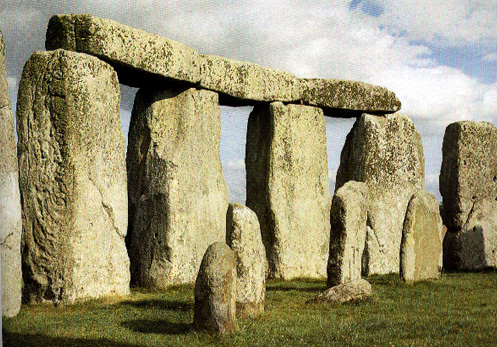
Part of the outer Sarsen Circle with lintels in place. In front of them are stones of the Bluestone Horseshoe (see below) Sarsen stones are hard-grained sandstone with a silaceous cement. They were probably brought to the site from the Marlborough Downs, about 30 kilometres to the north of Stonehenge. The Trilithons are ten upright stones arranged as five freestanding pairs each with a single horizontal lintel. They were erected within the Sarsen Circle in the form of a horseshoe with the open side facing north-east towards the main entrance of the monument. They were arranged symmetrically and graded in height; the tallest is in the central position. Only three of the five Trilithons are now complete with their lintels. The other two both have only one standing stone with the second stone and lintel lying on the ground.
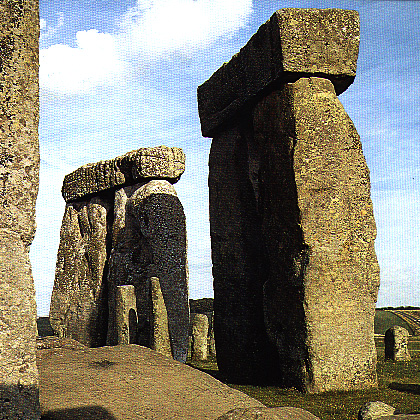
Two of the Trilithons In front of them can be seen two of the upright bluestones, which originally formed an oval inside the horseshoe of Trilithons Bluestones may have been added next (sub-phase 3iii) but were subsequently removed.

Stonehenge Phase III, sub-phase 3iv (c. 2550-1600 BCE) The Bluestone Oval and the Bluestone Circle
In sub-phase 3iv, a Bluestone Oval was added within the Trilithon Horseshoe and a Bluestone Circle added outside the Trilithon Horseshoe but inside the Sarsen Circle.
The term "Bluestone" refers to various types of mostly igneous rocks including dolerites, rhyolites, and volcanic ash.
It also includes some sandstones. The Bluestones at Stonehenge are believed to have originated from various outcrops in the Preseli Hills in Pembrokeshire in Wales.
How they were transported to the site at Stonehenge has been the subject of much speculation.
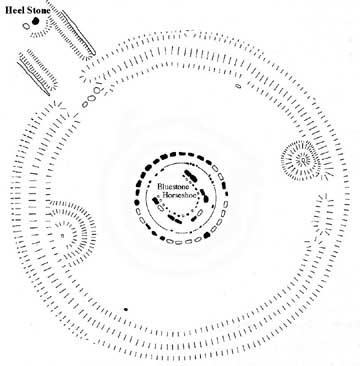
Stonehenge Phase III, sub-phase 3v (c. 2550-1600 BCE) The Bluestone Horseshoe In sub-phase 3v, an arc of stone was removed from the Bluestone Oval to form a Bluestone Horseshoe.
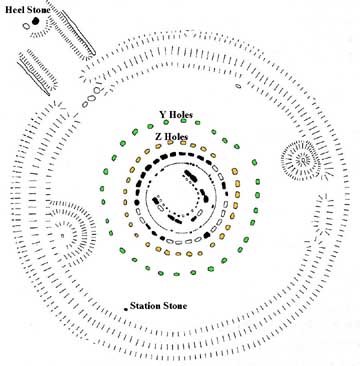
Stonehenge Phase III, sub-phase 3vi (c. 2550-1600 BCE) The Y and Z Holes In the final sub-phase (3vi), two circles, one inside the other, known as the Y and Z Holes were dug for the placement of stones but were never filled. Probably also dating to Phase III are the four Station Stones (only two of which survive, and one of them has fallen). These sarsen stones stood just inside the Bank on more or less the same line as the Aubrey Holes. Two of the Station Stones were surrounded by circular ditches 10 to 12 metres in diameter. These have caused the area enclosed by the ditch to appear mound-like and have lead to the erroneous identification of each mound as a burial barrow. Assigned to Phase III are also Stoneholes D and E and the recumbent sarsen known as the Slaughter Stone located on the north-east side in a break in the bank-and-ditch in what is regarded as the main entrance of the monument. At this time was also laid out an earthwork known as the Avenue that extends north-east from the break in the bank-and-ditch. Located further along the Avenue, and most likely dating to this period, is the so-called Heel Stone (Stone 96). The sarsen Heel Stone is approximately 16 feet high (4.88 metres), with another 4 feet (1.22 metres) buried below ground. The Heel Stone is surrounded by a circular ditch of approximately the same dimensions as the ditch surrounding each of the two Station Stones. The stone now leans out of vertical but most likely once stood upright. Originally, the Heel Stone may have been paired with another stone now missing (Stonehole 97).
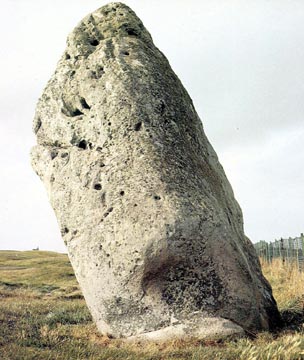
Heel Stone Finally, mention should be made of the so-called Altar Stone, a large dressed block of sandstone that lies embedded in the ground within the Trilithon Horseshoe and "in front of" the central and largest Trilithon pair. Two fallen stones now lie across it. The stone is believed to be Cosheston Beds Sandstone from south Wales, and is the only example of this type of stone at Stonehenge. It is 16 feet long (4.9 metres), 3 feet 6 inches wide (1 metre), and 1 foot 9 inches thick (0.5 metres).
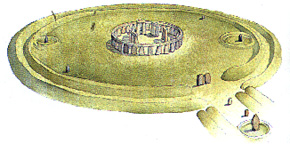
Stonehenge at the end of Phase III Image from Jean-Pierre Mohen The World of Megaliths (New York: Facts on File, 1990), page 131
|
|
page online since October 10, 1996
revised August 22, 2001 modified February 19, 2002 modified again February 7, 2008 |


